
Entering the European market for leather accessories
Europe is one of the world’s largest and most interesting markets for leather accessories. However, the European market is not an easy market. Requirements for quality, pricing and flexibility are high, and there is a great deal of competition. This report will help you understand how you can best prepare and present yourself when trying to do business with European buyers of leather accessories.
Contents of this page
- What requirements and certifications must leather accessories comply with to be allowed on the European market?
- Through what channels can you get leather accessories on the European market?
- What competition do you face on the European leather accessories market?
- What are the prices for leather accessories on the European market?
1. What requirements and certifications must leather accessories comply with to be allowed on the European market?
There are a range of requirements you need to meet when exporting leather accessories to Europe. Some are mandatory – both legal and non-legal. Others are voluntary. Meeting them can give you a competitive advantage. Some requirements only apply to certain niches in the leather accessories market.
What are mandatory requirements?
There are many legal requirements for exporting leather accessories to Europe. They concern product safety, the use of chemicals (REACH), quality and labelling. Follow these steps to ensure that your product complies with the relevant legal requirements:
- Make sure your product complies with the European Union's (EU) General Product Safety Directive (GPSD: 2001/95/EC). If your buyer supplied the product design, it is their responsibility to guarantee it is safe for consumers to use.
- Make sure you meet the EU’s REACH Regulation. This regulation restricts the use of chemicals, including certain azo dyes, nonylphenol and nonylphenol ethoxylates, heavy metals (for example, mercury, cadmium and lead), chromium (the widely used chromium III can transform into the hazardous chromium VI under certain production and storage circumstances), formaldehyde, nickel (may occur in metal trims), polycyclic-aromatic hydrocarbons (PAHs) and phthalates (may occur in PVC parts).
- Specify the material composition of every item of the leather accessories that you export to the EU in accordance with Regulation (EU) 1007/2011.
- Do not violate any Intellectual Property (IP) rights and do not copy or share designs with other buyers. If your buyer provides the design, they will be liable if the item is found to violate a property right.
Tips:
- Read the CBI study on Buyer Requirements for more information on legal requirements on exporting to Europe.
- Check news on the REACH candidate list. REACH is updated regularly to include more restricted substances. Certain standards, such as the Oeko-Tex® Leather standard, guarantee compliance with both REACH and the substances on the candidate list.
- Check the EU Access2Markets online helpdesk for an overview of information on legal procedures and the latest news and updates. You can also apply to join live training webinars on export to Europe on this website.
- Test your materials if you want to be sure that your products are REACH-compliant. Most European buyers will not ask for testing for small orders, but you will bear all expenses involved if illegal chemicals are discovered after delivery.
Figure 1: Try to focus on niche products, special materials and simple yet functional and fashionable designs
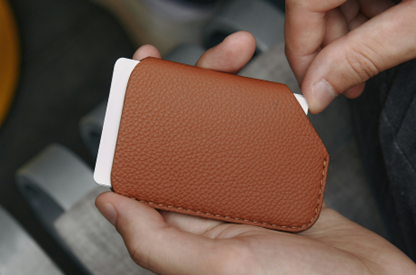
Source: Ocult Store on Unsplash
Non-legal mandatory requirements
Buyers may confront you with additional, company-specific terms and conditions. These requirements are usually written down in a buyer manual. By signing a contract with your new buyer, you confirm that you will comply with all the requirements listed in the manual. You will be held accountable if there are any problems after the delivery of an order. The following topics may be found in a buyer manual.
Requirements regarding tanning methods
Buyers will always search for the type of leather that best fits their product. They will first think about the tanning method because it determines the look and feel of the leather, although a lot can be adjusted during the ‘finishing’ of the leather. Leather can be tanned using the following tanning methods:
- Vegetable tanned;
- Semi-veg;
- Chrome-tanned;
- Low-chrome; and
- Chrome-free.
Each type of leather is suitable for different products. For instance, vegetable tanned leather is relatively firm, thick and has deep, warm colours. It is mostly used for bags and belts. Vegetable tanned leather is popular in northern European countries, where consumers appreciate its ‘natural look’.
Chrome tanning may result in softer, thinner and suppler leathers, which can be used in any product. As a result, until recently, wallets and gloves were mostly made from chrome-tanned leathers. Nowadays, certain vegetable and leathers tanned without chrome are able to provide the same characteristics.
Sustainability and consumer safety concerns are other reasons buyers request certain types of leather. Vegetable tanned leather is popular among European brands that promote themselves as ‘eco-friendly’, although a lot is still unknown about the exact environmental impact of each tanning method. A lot depends on how tanneries manage their inputs and waste.
Ever more buyers require chrome-free tanned leathers for reasons of sustainability and consumer safety. This is done to avoid the risk of formation of Chromium VI in leather (which is restricted by REACH). Between 2014 and 2020, the proportion of chrome-tanned leather fell from 85% to 75%, and this trend is expected to continue. Chrome-free can be either vegetable tanned or wet-white tanned leather. Innovations in these tanning methods have led to leathers that are closer to the qualities of chrome-tanned leather than ever.
Quality requirements regarding finished leather
Finished leather is available in different qualities (high to low): full-grain aniline and semi-aniline, pigmented smooth leather, nubuck, suede, split leather and bonded leather. The number of scars, cuts and flaws is expressed in grades: A (lowest number of defects, highest quality), B and C (highest number, lowest quality).
Most buyers will require a certain type of leather and leave the selection of grades up to you. Lower grade leathers are cheaper but using them will increase wastage because there are more flaws you need to work around. In any case, buyers will reject ready-made products with too many visible flaws in the leather, unless the natural defects are part of the design.
Expect buyers to also set requirements regarding colour fastness, especially if you use suede-type leathers.
Figure 2: European buyers expect impeccable workmanship in every market segment, including the budget market
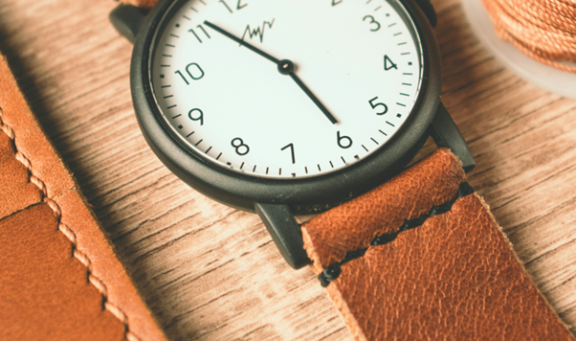
Source: Konstantin Evdokimov on Unsplash
Acceptable quality limit
To guarantee product quality, your buyer may set an acceptable quality limit (AQL). This refers to the worst quality level that is still tolerable. For instance, AQL 2.5 means that your buyer will reject a batch if more than 2.5% of the items are defective.
Common quality defects in ready-made leather fashion accessories are:
- Uneven, wonky cut leather parts and patches
- Uneven, wonky stitching lines
- Uneven colouring
- Visible material defects due to the use of lower grade leathers
Packaging requirements
In most cases, buyers will give you instructions on how to package orders. If you agree on delivering Free on Board (FOB), your buyer will clear customs in the country of import. It is their responsibility to ensure the instructions on the packaging comply with EU import procedures.
It is always a good idea to try to reduce the environmental impact and financial cost of packaging materials. For instance, you can use materials made from recycled cardboard or biodegradable plastics.
If you have ordered items made with chrome-tanned leather, make sure that the items are stored and transported properly. Changes in temperature during handling can transform Chromium III into the prohibited Chrome VI, which would lead to your product being non-compliant with REACH (see above).
A common requirement in the leather accessories industry is to store, pack and ship your goods in dry, well-ventilated conditions. Leather may absorb moisture from the air. This can lead to loss of sheen, bad smell, spots, stains and the growth of mould or mildew. Packing your leather goods with silica gel packets can reduce excess moisture during shipment. Wrap metal accessories separately so they do not damage the leather.
Payment terms
For first-time orders, European buyers may give you a down payment (for example, 30%) and pay the rest (70%) once the order has been completed. The safest payment method for you is the LC (Letter of Credit). With an LC, the buyer’s bank must pay the supplier if both parties meet the conditions they have agreed upon. However, many buyers no longer favour LC payments because this will block their cash flow. Be aware that LCs do not offer financial protection against bankruptcy.
For further orders, most European buyers will ask for a TT (Telegraphic Transfer) after 30, 60, 90 or sometimes even 120 days. This means you, as a manufacturer, finish production and then hand over the shipment to the buyer before payment is due, including the original documents. The payment will be made after the number of days you have agreed on with the buyer. This is a risky payment method because you take on full financial risk.
Transparency
Supply chain transparency is very important for European buyers. This is because of ever stricter laws, such as the EU’s CSDDD, CSRD and EUDR. This currently only applies to leather, not leather goods, but this may change. Transparency includes tracing back which suppliers produced the leather, but also measuring and disclosing the environmental impact of the materials, such as the carbon footprint. Always help buyers gain insight into their entire supply chain. Read the CBI study Tips to go green for more information.
Restricted substances
Your buyer’s manual may contain a Restricted Substances List (RSL). These lists are often inspired by the industry platform AFIRM and the guideline on safe chemicals use from the Zero Discharge of Hazardous Chemicals (ZDHC) foundation. Download the ZDHC Conformance Guidance for more information.
Recycling
Recycling materials is ever more important for European buyers. This is because the EU regularly introduces new legal measures, including the ‘right to repair’ and an EU-wide EPR scheme (extended producer responsibility), which makes companies responsible for how their products are disposed of, recycled or repaired. Some countries have national EPR schemes already.
Leather is still difficult to recycle, but there are some good examples. Ideally, manufacturers should play a significant role in remanufacturing, refurbishing and repairing leather accessories at the end of their lifecycle.
- Soruka creates sustainable, handcrafted and responsibly-made recycled leather bags, wallets and footwear using leftover leather clippings.
- Real man leather focusses on recycling and reusing leather (for example, old leather jackets) to create a variety of leather accessories including bags, wallets, belts, tool belts, binders and book covers.
- Looptworks recycles leather seat covers from Southwest Airlines into handbags and leather accessories.
Equality
Your buyer may also require that you pay attention to diversity and inclusion in your workforce. Every individual in your company should have equal opportunities, regardless of gender, race, religion or any other characteristics. This can result in greater creativity, innovation and problem-solving.
Carbon footprint
Many European brands have committed to climate neutrality. Calculating the carbon footprint of a leather accessory item is a complicated process, but several organisations have set benchmarks for certain materials and products. Check the CBI study Tips to go green for more information.
Sustainable production and materials
Buyers of leather accessories appreciate advice on the use of sustainable materials in leather accessories.
- Buyers may require you to only use vegetable tanned or chrome-free leathers (see above).
- Suppliers of leather tanning chemicals and processes keep introducing sustainable solutions. Check, for instance, DriTan Technology by ECCO, Zeology by Neratanning and EasyWhite™ by Stahl.
- Another sustainability problem during tanning is the use of salt. Many tanners and their suppliers are switching to techniques that require less or no salt. For instance, look into Litehide.
- To prevent wastage, invest in computer-controlled cutting machines to optimise the use of leather skins, or discuss the option of using smaller patches in the designs with your buyer.
Certification and standards
Many leather accessory buyers require suppliers to get certified for sustainable and/or fair production or the use of sustainable materials. The following standards and certifications are the most popular in Europe. Note that BSCI is almost a standard requirement for many European apparel companies.
Table 1: Europe’s most popular standards for leather accessories
| Name of standard | Logo | Type of compliance | Further information on getting certification |
| Leather Working Group | 
| Environmental, social | Leather Working Group |
| Naturleder | 
| Environmental, quality | Naturleder |
| Sustainable Leather Foundation | Environmental, social | Sustainable Leather Foundation | |
| Oeko-Tex® Leather standard | 
| Environmental | Check here for more information |
| Amfori BSCI | Social | On invitation by buyers. Amfori provides a list of organisations that can perform an audit | |
| SA8000® | 
| Social | Check the SA8000 certification process here |
| WRAP | 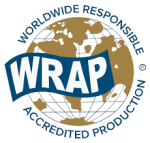
| Social | Check the WRAP certification process here |
| Sedex | 
| Social, environmental | Check the Sedex certification process here |
| B-Corp | 
| Social, environmental | Check the B-corp certification process here |
| ZDHC | Environmental (chemical use) | The ZDHC provides a guide that outlines the requirements for indicating ZDHC MRSL conformance | |
| Bluesign | Environmental (sustainable production) | Check the Bluesign services for manufacturers | |
| Cradle to Cradle Certified™ | 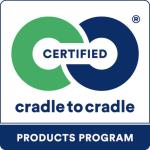
| Environmental, social (material recycling, social responsibility, chemical management) | Check how to get certified |
Source: FT Journalistiek
What additional requirements and certifications do buyers often have?
In addition to legal and non-legal mandatory requirements, there are many services that buyers implicitly expect or at least greatly appreciate if you want to do business with them.
Product design and development
Most buyers have their own design teams and do not exclusively rely on the collections that factories present to them. Still, having your own ideas about product design and development will be highly appreciated. Buyers always look for special designs, materials, surprising colours, finishes, trims, types of embossing and production methods to help them stand out in the market. Consider, for instance:
- Modular designs, which allow users to adapt accessories to different needs or styles, enhancing both utility and longevity
- Smart features like built-in trackers (airtags) or RFID-blocking materials for security
- The integration of solar panels into bags for charging devices
- The use of recycled or plant-based leather alternatives to minimise environmental impact
Communication
Always communicate with your buyers and manage expectations. Reply to every email, call and WhatsApp message within 24 hours, even if it is just to confirm that you have received the message and will reply more completely later. If you encounter a problem with a production order, immediately notify your buyer and try to offer a solution. Create a T&A (time and arrival) of every order and share it with your buyer. This file will help you manage expectations, monitor progress and is the best way to guarantee on-time delivery.
Flexibility
If you want to start a business relationship with a European buyer, be prepared to accept small, complicated orders first. Buyers will test your factory before giving you large, easy orders. Make sure that buyers will not continue to place only difficult orders with you and convenient orders elsewhere at the start.
In their first order, expect European buyers to require:
- Order quantities below your normal minimum order quantity (MOQ);
- A price level that is lower than you would normally accept for small quantity orders:
- High material quality and impeccable workmanship.
What are the requirements for niche markets?
There are a lot of interesting niches in leather accessories. Be aware that niche buyers usually offer smaller orders and require a relatively high service level. This means you need to adjust your manufacturing and sourcing setup if you want to be profitable.
Organic leather
Although there is no official definition of organic leather, the term suggests that the leather is tanned with organic tanning agents and dyes and made with skins from animals that are fed organically. Check Meindl, for example, a German footwear brand. For its Meindl Identity product line, the company only used leather from organically reared cattle from a specific region in Germany.
Deforestation-free leather
The Deforestation-Free Call to Action for Leather is an initiative led by Textile Exchange, the Leather Working Group and the World Wildlife Fund. Brands that have signed the pledge promise to only source their bovine leather from supply chains in which no forests are cut down (or ‘land that has been or will have been converted from natural habitat by 2030’). Adhere to your buyer’s requirements by mapping your supply chain, offering product lifecycle assessments and calculating your carbon footprint.
Recycled leather
A growing number of European fashion brands have started to use recycled leather. The term ‘recycled leather’ usually describes a composite material made from shredded cutting waste. For an example, take a look at Salamander’s collection of recycled leather fibre fabrics. Recycled leather can also refer to items made from leather patches cut out of used leather fashion items and upholstery. Beware that some recycled leathers are vulnerable to water. Watch this video on YouTube for an explanation of the basic steps involved in recycling leather.
Natural dyes
Some buyers may require leathers dyed using only natural ingredients. Natural dyes are typically used for finishing vegetable tanned leathers. Natural dyestuffs can include plants, such as berries, oils and coffee. Be careful with naturally dyed leathers because they tend to discolour quickly in sunlight.
Plant-based materials
European buyers are increasingly experimenting with plant-based materials as alternatives to leather. These leather-like materials are often branded as vegan, meaning no animals were used in the process of making the product. However, these products may be produced using synthetic binders, such as PU. Most of these materials have a specific look and feel, clearly different from real leather. For some examples, take a look at:
- Pelcor– made from cork
- Uashmama – made from paper
- Le Qara – made from micro-organisms
- Piñatex – uses fibres from pineapple leaves
- Mylo – made from mycelium
- Vegea – made from grape waste, vegetal oils and natural fibres
- Desserto – made from organically-grown prickly pear cacti
- Mirum – a recyclable, circular and 100% plastic-free leather alternative made from natural fibres
- Uppeal – made from apple waste
Figure 3: Europe is a large but highly competitive market for mainstream leather accessories. Try to focus on niche products, such as leather-covered accessories and interior products
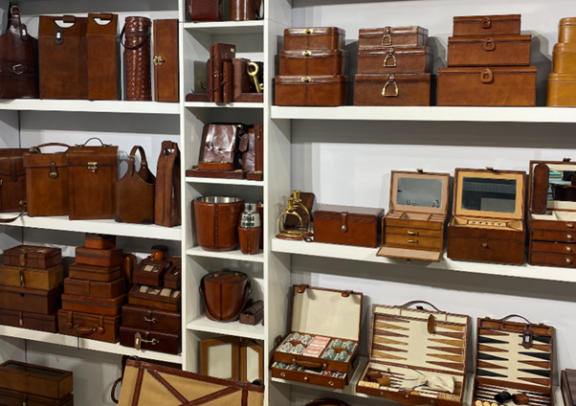
Source: Forward in Fashion
2. Through what channels can you get leather accessories on the European market?
There are a lot of sales channels you can use to get your product onto the European market. Each has its own opportunities and challenges. Make sure to study them and optimise your offer.
How is the end-market segmented?
The European leather accessories market is best segmented by price/quality. Each segment requires specific strategies in terms of product design, quality, pricing (depending on your level of craftmanship, efficiency and production set-up), branding and distribution.
Table 2: Market segmentation of leather accessories
| Consumer type | Description | Price level | Fashion | Material use | Functionality |
| Luxury consumer segment (luxury market) | High-end leather accessories for consumers who focus on luxury, exclusivity and prestige. | Very high prices | Unique, creative, hand-made designs, high-level craftmanship | High-quality, (sometimes exotic) leathers and trims, nominated suppliers | Highly fashionable and functional |
Mid-range consumer segment (upper middle market) | Leather accessories that balance quality and affordability, targeting consumers with moderate budgets seeking value for money. | Medium-high prices | Fashionable designs inspired by the luxury market but manufactured with more affordable materials | High-quality leathers, sometimes nominated suppliers, sustainable materials | Fashionable and functional |
Budget consumer segment (budget market) | Affordable leather accessories for price-conscious consumers who prioritise cost-effectiveness and practicality. | Extremely low prices (volume production) | Focus on basic styles with trendy details | Medium quality | Functional and sometimes fashionable |
Source: FT Journalistiek
Tips:
- Look at online shopping platforms for leather accessories, like Yoox (luxury and upper middle market segments), Zalando (all market segments) and Asos (middle and budget market), for inspiration on styles and colours.
- Find your inspiration in the luxury segment but never copy the styles exactly.
- Study your prospective clients’ collections to develop a product at a rate that meets their expectations.
Through what channels does the product end up on the end-market?
Always try to find out if you are dealing with a brand, a retailer, an intermediary or some other type of buyer. Every buyer has a different sourcing and sales strategy, and different challenges. Adapt your pitch accordingly.
Table 3: Different sales channels and their characteristics
| Sales channel | Who’s your buyer? | Requirements | Examples |
| 1 | European end-consumer | You will need to invest in a web shop, stock, order management and customer service. Your biggest challenges will be return policies and a lack of brand awareness. Note that online B2C platforms may require a percentage of each sale and/or a monthly fee. | Alibaba, Wish, Amazon, ASOS marketplace, Rakuten (Spain and France), Allegro (Poland), Bol (the Netherlands, Belgium), Wolf & Badger |
| 2 | Online multi-brand platform | Online multi-brand platforms sell existing apparel and other brands and often develop their own private collections – mostly value brands. They can detect market trends very fast and will react to sales data immediately. Usually, these companies will place small test orders first. If the item sells well, they will place the actual production order. Fast delivery is a must. | Zalando, Asos, Farfetch, Boozt (Scandinavia), About you, La Redoute (France), Yoox |
| 3 | Retailer | Besides big chains, most leather accessories are sold in boutique shops that can be found in almost every European city. These shops sell existing brands, but some also order products specially developed and manufactured for them. | H&M, Inditex, Primark, Next, M&S, C&A, Mango, KiK, Lancaster (France) Weidner (Austria), Van Os (the Netherlands) |
| 4 | Brand | Apparel and leather accessory brands typically develop collections 6 to 9 months in advance. You will need a sample room, as brands require salesman samples (SMS) of each collection style. Every salesman sample needs to be actual, meaning it should look exactly like the product will in the shop. It may take many months before orders are placed. | Hermès, Louis Vuitton, Bally, Montblanc, Ted Baker, French Connection, Picard, Burkely, Sandqvist, Royal Republic, Liebeskind |
| 5 | Intermediary | Agents, traders, importers and private label companies sell your product on to buyers up the value chain. They are extremely price focussed and require flexibility in terms of quantity and quality. Some are located near or in the production countries and primarily do sourcing and logistics. Others work from Europe and also do market research, design and stock keeping. Their service level determines the commission rate they charge. | Li & Fung, Miles Group, Dugros |
Source: FT Journalistiek
Tips:
- Check the online Retail-Index, which offers profiles for big apparel retailers in Europe, including those that sell leather accessories.
- Read the CBI study on finding buyers for an extensive overview of European fashion market segments, channels and requirements.
- Find intermediaries that are specialised in leather accessories by using an online search engine. Use keywords like ‘full service’, ‘garment’ or ‘leather fashion’, ‘accessories’ (‘bags’, ‘belts’, and so on) plus ‘solution’. Traders’ websites usually show the brands they work with.
Figure 4: The market value chain for leather accessories
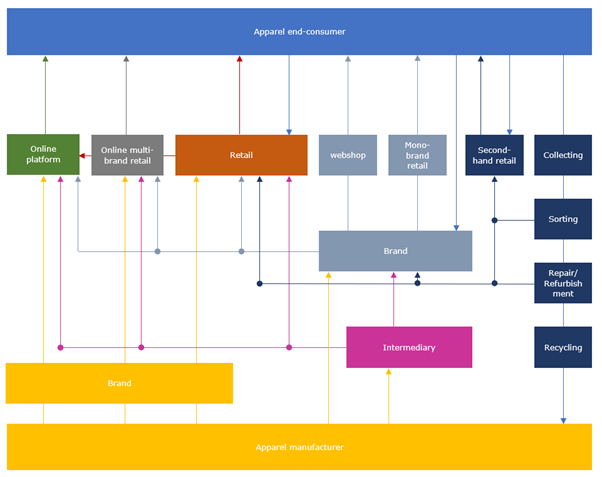
Source: FT Journalistiek
Tips:
- Research the market in which your ideal buyers operate and adjust your proposition to their requirements and ambitions.
- Determine your USPs before you approach any buyers. Note that selling your company is even more important than selling your product, so focus on certifications and sustainable production. For more information, read our report on trends in the European apparel market.
- Follow potential buyers on social media, including LinkedIn, YouTube, X, Instagram and TikTok. This will provide you with company updates and news on their latest collections and travel schedules. They may also follow you in return.
What is the most interesting channel for you?
When you have little experience exporting to Europe, intermediaries, small brands and boutique shops are likely the best starting point. You should only consider big brands and retailers as potential buyers if you have the right certifications, production efficiency and can handle large volume orders. End-consumers are a difficult group because of high service demands. Basic, non-worn and highly functional leather accessories, however, are relatively easy to sell on online B2C platforms.
Intermediaries
Agents, traders, importers and private label companies are usually the first to explore new sourcing destinations, and they can be a great way to get introduced to the European market and its many brands. Be aware that intermediaries are very focussed on price. They act as ‘middle-men’ between you and companies further up the value chain, which means they need to keep their prices close to your factory price. This leaves little negotiation room for you as a manufacturer.
Tips:
- Study the requested service level for online companies because they differ from regular retailers. Speed and low MOQs are in particular demand.
- Find potential buyers at trade fairs for leather accessories. Even if you do not plan to attend, you can check the exhibitors list. For instance, take a look at the following trade fairs: Lineapelle in Italy and ILM in Germany.
- Study the requested certifications from your prospects and try to match requirements.
3. What competition do you face on the European leather accessories market?
Historically leather and leather goods are produced in almost every country worldwide. As a leather fashion accessories producer, you are therefore competing with thousands of suppliers from within and outside of Europe. However, European buyers are usually interested in hearing about new suppliers, so try to learn from the companies you are competing with and the conditions in the countries where they are installed.
Leather accessories are produced worldwide so you will likely face stiff competition in this market. The most important ways to beat the competition are by providing technical knowledge, service level, flexibility (the willingness to accept lower MOQs), efficiency and beneficial trade agreements.
Which countries are you competing with?
Leather has been produced all over the world since ancient times. Many countries today still have at least rudimentary leather industries. This means you may expect competition from many sides.
Table 4: Competing countries
| Country | Strengths | Weaknesses | Image in Europe | Future developments |
| India | price, flexibility, availability of leathers | relatively low speed, low service level, compliancy concerns, no General scheme of Preferences (GSP) | reasonable quality-price ratio | improving compliancy |
| China | design, innovation, local availability of leathers, faux leathers and trims | increasing costs, no GSP | inconsistent quality standards, reputational decline | buyers moving away to neighbouring countries |
| Italy | design, innovation | high prices | high quality | growing industry |
| Pakistan | price, availability of leathers | low flexibility, political instability | reasonable quality, difficulty of doing business | improving flexibility in MOQ |
| Ethiopia | flexibility, GSP, availability of hair sheep leathers | political instability | artisanal quality | safety improvements |
Source: FT Journalistiek
Tips:
- Visit the ’trends’ section on UNIDO’s leatherpanel.org for an overview of global, regional and national trends in various leather-producing countries.
- Study the conditions in the countries where your competitors are, compare their strengths and weaknesses to yours, and advertise the advantages of doing business with you. Besides GSP, consider factors such as distance to Europe, ease of doing business and transparency.
Which companies are you competing with?
Sammy handmade in Ethiopia has access to high-quality raw materials. Ethiopia is known for producing high-quality hair sheep leather, allowing the production of leather accessories with excellent durability and design. However, Ethiopia faces infrastructure challenges. Despite improvements in recent years, the country still struggles with an unreliable power supply, unreliable transportation networks and limited access to water. These factors can lead to delays in production, increased operating costs and logistical difficulties.
Stan India. One of the strengths of working with a leather factory in India is its access to a highly skilled workforce. India has a long-standing tradition of leather craftsmanship, allowing for high-quality leather accessories with unique detailing and craftsmanship. India, however, is not known for its speed of production.
Campel Italy has a heritage of craftsmanship. Italian leather goods are known worldwide for their superior quality, attention to detail and excellent design. The disadvantages of production in Europe are the relatively higher production costs compared to factories in developing countries. Factors such as labour expenses, overhead costs and regulatory standards contribute to the overall higher cost of manufacturing.
Tips:
- Study your competition, learn and adapt. What kind of production setups do they have? Do they invest in innovative and sustainable production? What designs and styles do they offer? Which markets do they target? How do they present their company and their product to potential buyers?
- Check industry websites, such as Leatherbiz and International Leather Maker, or sign up for trend forecaster WGSN’s newsletter to get an idea of the latest trends in the leather accessory industry.
- Read the CBI study 11 Tips for Doing Business with European Buyers to learn how to approach and engage with buyers.
Which products are you competing with?
Leather accessories compete with various other types of accessories, depending on the context and consumer preferences. Some product categories that can be considered as competitors to leather accessories are given below.
Synthetic fabrics
Accessories made from synthetic fabrics, like nylon, polyester and microfibre, are another alternative to leather accessories. These materials are lightweight, water-resistant and often more affordable than leather, making them popular choices for wallets and other accessories, especially for outdoor and sporting activities.
Vegan leather alternatives
With the growing awareness of ethical and environmental concerns, vegan leather accessories made from materials such as polyurethane (PU) and natural fibres, like cork and pineapple leaf fibre, are gaining popularity. PU-based faux leathers also appeal to price-conscious end-consumers as they are much cheaper than real leather and appear ever more similar.
Chrome-free leather accessories
If you are still using chrome-tanned leathers for your leather fashion accessories, expect competition from manufacturers that use chrome-free leathers (vegetable tanned and wet-white). Although it is estimated that more than 75% of all leathers worldwide are still chrome-tanned, the demand for chrome-free is rising.
Recycled materials
Accessories made from recycled materials, such as recycled plastic and rubber, are in competition with leather accessories because they offer environmentally friendly alternatives. These products help reduce waste and environmental impact while still providing stylish and durable options for consumers.
Canvas
Canvas is a popular alternative to leather for accessories such as wallets, belts and watch straps. Canvas is durable, lightweight and often more affordable than leather, making it a competitive choice for those looking for functional and stylish accessories that do not use animal materials.
Wood
Wood accessories, including watches, sunglasses and jewellery, offer an eco-friendly alternative to traditional leather goods. Wood is a sustainable material that can be sourced responsibly. This appeals to many consumers.
Tips:
- Create a company presentation that shows the quality of your craftmanship and manufacturing. Positioning your product starts with positioning your company.
- After you have created a company presentation, focus on presenting your product to highlight its unique character, quality and innovation.
- Keep abreast of trends and new developments in leather and leather-like materials by reading websites such as Material District and Springwise, or create an alert on Google.com for news about ‘leather innovation’.
4. What are the prices for leather accessories on the European market?
The factory price of your product (your ‘FOB price’: Free On Board) depends on many factors. These include the cost of materials, the efficiency of your employees and your overhead and profit margins. The average cost breakdown of your FOB price should look like this:
Source: FT Journalistiek
Note that the cost price of leather accessories is often calculated based on the consumption of the leather. If the leather is cutting waste, the value represented in the graphic above goes down.
Percentages may differ per factory and per order. Some factories may accept lower profit margins during off-season periods or if order volumes are high. The percentages for labour versus materials may also differ depending on the efficiency and wage level of the workforce and the price of the materials. Efficiency increases, and material prices go down for producing large volume orders.
Retail pricing
The retail price of a leather bag is, on average, 4 to 8 times the FOB price. This is called the ‘retail markup’. It follows that the FOB price is, on average, 12.5–25% of the retail price of the product. This is why buyers may offer you an FOB price of 20 EUR for an item sold in Europe for a retail price of 100 EUR or more. However, exceptions do occur. In the budget market, some large European retail chains may only double the FOB price.
Retailers mark up the FOB price by 4 to 8 times because they need to account for a range of factors, including import duties, transport, rent, marketing, overhead, stock keeping, markdowns and VAT (17–27% in EU countries).
Source: Eurostat 2022
According to Eurostat’s 2022 price level index for beverages, food, apparel and footwear in Europe, of the top 3 European importers, France has the highest price level, at 105.4 points, compared to the European average of 100. It is followed by Germany (98.7) and Spain (84.8). Denmark is the EU country with the highest price point (134.4), while Switzerland is the most expensive European country for apparel (141.5).
FT Journalistiek carried out this study on behalf of CBI.
Please review our market information disclaimer.
Search
Enter search terms to find market research
